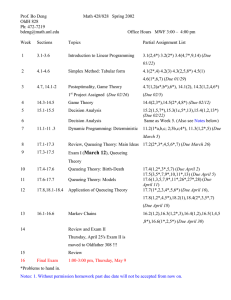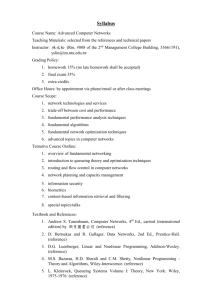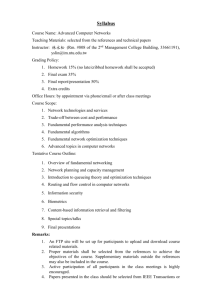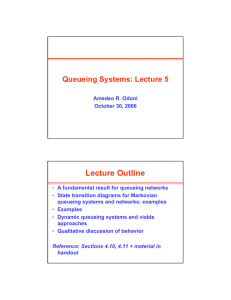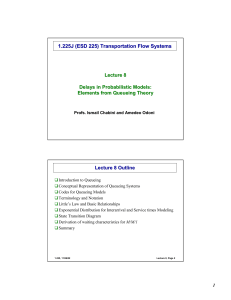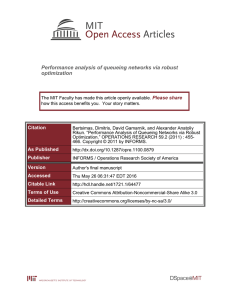1 Queueing systems
advertisement
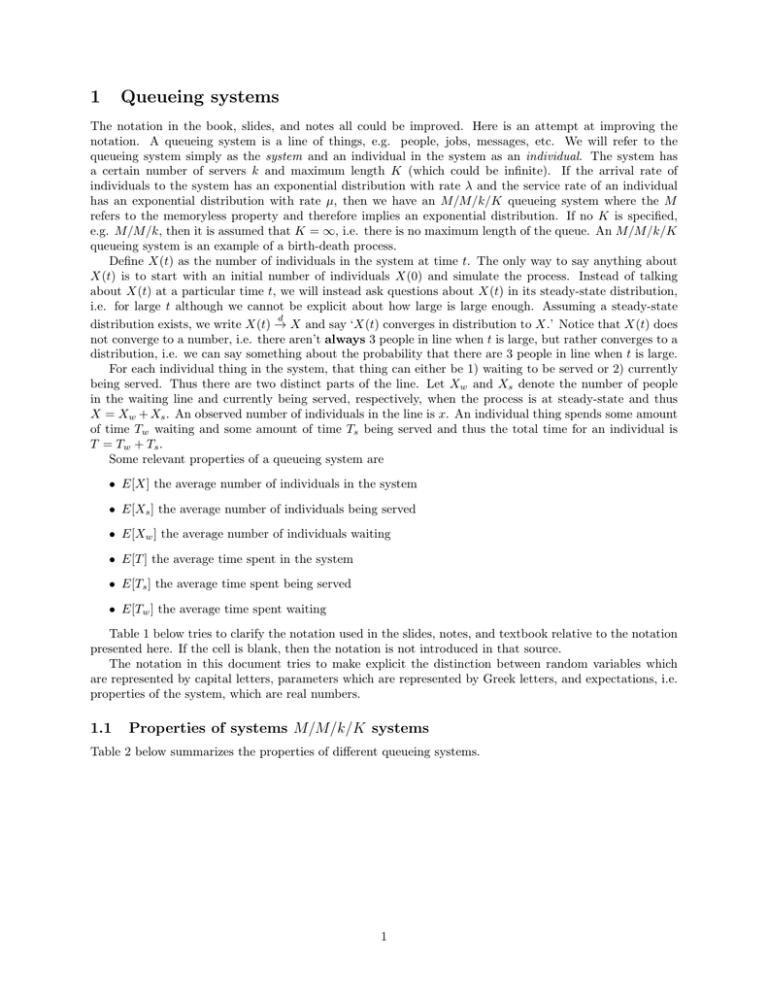
1 Queueing systems The notation in the book, slides, and notes all could be improved. Here is an attempt at improving the notation. A queueing system is a line of things, e.g. people, jobs, messages, etc. We will refer to the queueing system simply as the system and an individual in the system as an individual. The system has a certain number of servers k and maximum length K (which could be infinite). If the arrival rate of individuals to the system has an exponential distribution with rate λ and the service rate of an individual has an exponential distribution with rate µ, then we have an M/M/k/K queueing system where the M refers to the memoryless property and therefore implies an exponential distribution. If no K is specified, e.g. M/M/k, then it is assumed that K = ∞, i.e. there is no maximum length of the queue. An M/M/k/K queueing system is an example of a birth-death process. Define X(t) as the number of individuals in the system at time t. The only way to say anything about X(t) is to start with an initial number of individuals X(0) and simulate the process. Instead of talking about X(t) at a particular time t, we will instead ask questions about X(t) in its steady-state distribution, i.e. for large t although we cannot be explicit about how large is large enough. Assuming a steady-state d distribution exists, we write X(t) → X and say ‘X(t) converges in distribution to X.’ Notice that X(t) does not converge to a number, i.e. there aren’t always 3 people in line when t is large, but rather converges to a distribution, i.e. we can say something about the probability that there are 3 people in line when t is large. For each individual thing in the system, that thing can either be 1) waiting to be served or 2) currently being served. Thus there are two distinct parts of the line. Let Xw and Xs denote the number of people in the waiting line and currently being served, respectively, when the process is at steady-state and thus X = Xw + Xs . An observed number of individuals in the line is x. An individual thing spends some amount of time Tw waiting and some amount of time Ts being served and thus the total time for an individual is T = Tw + Ts . Some relevant properties of a queueing system are • E[X] the average number of individuals in the system • E[Xs ] the average number of individuals being served • E[Xw ] the average number of individuals waiting • E[T ] the average time spent in the system • E[Ts ] the average time spent being served • E[Tw ] the average time spent waiting Table 1 below tries to clarify the notation used in the slides, notes, and textbook relative to the notation presented here. If the cell is blank, then the notation is not introduced in that source. The notation in this document tries to make explicit the distinction between random variables which are represented by capital letters, parameters which are represented by Greek letters, and expectations, i.e. properties of the system, which are real numbers. 1.1 Properties of systems M/M/k/K systems Table 2 below summarizes the properties of different queueing systems. 1 Table 1: Notation for queueing systems used in this document (Here), in the lectures slides and Hoffman notes (Slides/notes), and used in the textbook. Here Slides/notes x k X(t) X(t) and N (t) Xs (t) Xw (t) X X(t) for large t Xs Xw T Ts Tw q(t) for large t k c K K λ λ µ µ 1/λ 1/λ a = λ/µ a = λ/µ ρ = a/k ρ = a/c E[X] L E[Xs ] Ls E[Xw ] Lq E[T ] W E[Ts ] = 1/µ Ws = 1/µ E[Tw ] Wq P (X = x) px Textbook x X(t) Xs (t) Xw (t) X Xs Xw R S W k K λA λS µA r = λA /λS E(X) E(Xs ) E(Xw ) E(R) E(S) = µS E(W ) πx Table 2: Properties for M/M/k/K queueing systems System P (X = 0) = p0 M/M/1 M/M/1/K 1−a 1−aK+1 1−a P (X = x) = px ax (1 − a) λa λ E[X] = L E[Xs ] = Ls E[Xw ] = Lq E[T ] = W E[Ts ] = Ws E[Tw ] = Wq a 1−a a a2 1−a 1 1 µ 1−a 1 µ 1 a µ 1−a ax p0 M/M/k i −1 ax ak x=0 x! + (1−ρ)k! hP k−1 x a x! p0 ax x−k p0 x! ρ (1 − pK )λ a 1−a x≤k x>k M/M/k/K M/M/∞ −1 P PK k k−1 ax + x=k ak! ρx−k ( x=0x x! a x≤k x! p0 ak x−k ρ p k <x≤K 0 k! e−a x e−a ax! − L − Lq Wq λa L/λa ρ p0 ak! (1−ρ) 2 Ws + Wq (1 − pK )λ PK x=0 xpx L − Lq Wq λ a L/λa 1 µ 1 µ 1 µ 1 µ W − Ws Lq /λ W − Ws 0 λ (K+1)aK+1 1−aK+1 Wλ L − Lq k 2 λ a a 0 a


